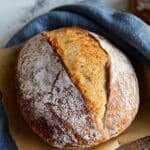Rustic Sourdough Bread Recipe
This Rustic Sourdough recipe guides you through making a traditional, no-knead loaf with a crisp crust and chewy interior, leveraging a long ferment and cold proof for rich flavor development. Using both bread flour and whole wheat flour, the dough undergoes an autolyse, optional stretch and folds, and a cold ferment before baking inside a hot Dutch oven to achieve the perfect artisan-style loaf.
- Prep Time: 1 hour 30 minutes
- Cook Time: 45 minutes
- Total Time: approximately 8 to 38 hours (including fermentation and cold proofing times)
- Yield: 1 loaf (about 900g to 1kg) 1x
- Category: Bread
- Method: Baking
- Cuisine: Artisan / Sourdough
- Diet: Vegetarian
Ingredients
Scale
Starter and Dough Ingredients
- 100 g Sourdough Starter (fed and bubbly)
- 250 g Bread Flour
- 250 g Whole Wheat Flour (or whole grain spelt flour)
- 315 g Water (plus a sprinkle if dough feels too dry)
- 10 g Salt
Instructions
- Autolyse: Weigh your sourdough starter and water into a large ceramic or glass bowl and mix briefly. Add the bread flour, whole wheat flour, and salt, then mix with the end of a wooden spoon until the dough is shaggy but combined. Cover the bowl with plastic wrap or a damp towel and let rest for 1 hour to fully hydrate the flour.
- Forming Up Your Dough: After autolyse, bring the dough together into a smooth ball by stretching it around the bowl and folding it over itself 20-25 times. The dough will be sticky but becomes smooth and shiny as you work it. Cover again with plastic wrap.
- Stretch & Folds (Optional): For better structure and gluten development, perform 4-6 sets of stretch and folds, each consisting of stretching the dough over itself 4 times with 15 minutes rest between each set. This step is optional for a rustic bread.
- Bulk Ferment: Cover the dough with cling film or a damp towel and let it ferment at room temperature. This long fermentation develops flavor and texture (approximately 2-4 hours depending on room temperature).
- Shaping Your Dough: Flour your countertop lightly with rice flour to prevent sticking. Gently ease the dough out of the bowl using a silicone scraper so the smooth top lands on the counter. Shape the dough into your preferred form, such as a batard, to create surface tension.
- Placing in Banneton: Transfer the shaped dough into a banneton or a bowl lined with a floured tea towel, placing the seam side up to achieve aesthetic lines when baked. Dust with extra rice flour as needed, handling the dough gently to preserve air bubbles.
- Preparing the Banneton or Bowl: Liberally flour your banneton or tea towel-lined bowl with rice flour to prevent sticking. The dough should retain its shape snugly in the container.
- Cold Ferment: Cover the dough loosely with a plastic bag or damp towel and refrigerate for at least 5 hours, up to 36 hours. The longer cold ferment enhances the crust’s blisters and deepens sourdough flavor, also forming a skin that aids scoring.
- Preparing to Bake: Preheat your oven to 230°C (450°F) with a Dutch oven inside for about 1 hour to ensure it’s very hot. Keep the dough in the fridge until the last minute to ensure an excellent oven spring.
- Baking Your Sourdough: Remove the dough from the fridge and place it on a large sheet of baking paper. Score the top with a sharp blade or knife. Remove the hot Dutch oven from the oven carefully, lift the dough using the baking paper, and place it inside. Cover with the lid and bake for 30 minutes at 230°C (450°F), then remove the lid and bake for an additional 10-15 minutes at 210°C (410°F) to develop a deep crust.
- Finishing Your Bake: Carefully remove the sourdough from the Dutch oven and transfer to a wire rack to cool completely before slicing to allow the crumb to set.
Notes
- Rice flour is ideal for dusting as it prevents sticking without adding gluten.
- The optional stretch and fold steps enhance dough strength but can be skipped for a rustic, no-knead style loaf.
- Cold fermenting in the refrigerator for longer than 24 hours improves flavor and crust texture.
- Using a Dutch oven traps steam, mimicking professional bakery ovens and yielding a better crust.
- Ensure your sourdough starter is active and bubbly before starting for best rise.
Keywords: rustic sourdough bread, sourdough recipe, no knead bread, artisan bread, bread baking, homemade sourdough
Find it online: https://platedbyemma.com/rustic-sourdough-bread-recipe/

